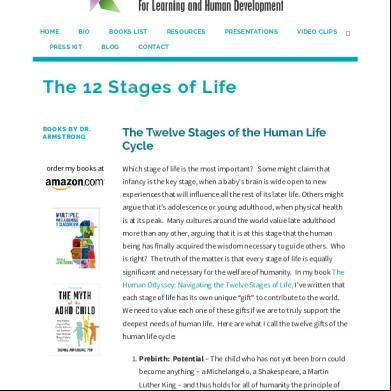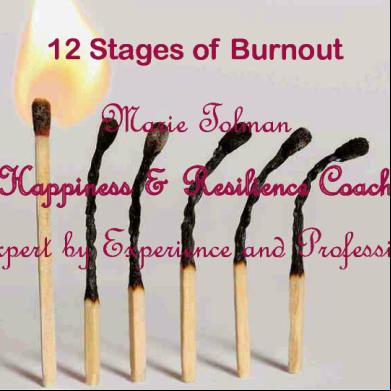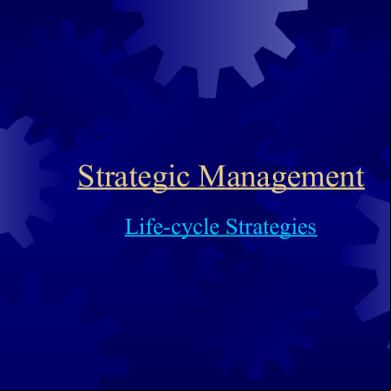The 12 Stages Of Life Thomas Armstrong Ph.d 1gl6l
This document was ed by and they confirmed that they have the permission to share it. If you are author or own the copyright of this book, please report to us by using this report form. Report l4457
Overview 6h3y3j
& View The 12 Stages Of Life Thomas Armstrong Ph.d as PDF for free.
More details h6z72
- Words: 1,291
- Pages: 4
1/21/2019
The 12 Stages of Life | Thomas Armstrong, Ph.D.
HOME
BIO
PRESS KIT
BOOKS LIST BLOG
RESOURCES
PRESENTATIONS
VIDEO CLIPS
The 12 Stages of Life BOOKS BY DR. ARMSTRONG
order my books at
The Twelve Stages of the Human Life Cycle Which stage of life is the most important? Some might claim that infancy is the key stage, when a baby’s brain is wide open to new experiences that will influence all the rest of its later life. Others might argue that it’s adolescence or young adulthood, when physical health is at its peak. Many cultures around the world value late adulthood more than any other, arguing that it is at this stage that the human being has finally acquired the wisdom necessary to guide others. Who is right? The truth of the matter is that every stage of life is equally significant and necessary for the welfare of humanity. In my book The Human Odyssey: Navigating the Twelve Stages of Life, I’ve written that each stage of life has its own unique “gi ” to contribute to the world. We need to value each one of these gi s if we are to truly the deepest needs of human life. Here are what I call the twelve gi s of the human life cycle: 1. Prebirth: Potential – The child who has not yet been born could become anything – a Michelangelo, a Shakespeare, a Martin Luther King – and thus holds for all of humanity the principle of what we all may yet become in our lives.
COPYRIGHT © THOMAS ARMSTRONG, PH.D. | WEBSITE DESIGN: GRAPHICSMITH
2. Birth: Hope – When a child is born, it instills in its parents and other caregivers a sense of optimism; a sense that this new life
http://www.institute4learning.com/resources/articles/the-12-stages-of-life/
1/4
1/21/2019
The 12 Stages of Life | Thomas Armstrong, Ph.D.
may bring something new and special into the world. Hence, the newborn represents the sense of hope that we all nourish inside of ourselves to make the world a better place. 3. Infancy (Ages 0-3): Vitality – The infant is a vibrant and seemingly unlimited source of energy. Babies thus represent the inner dynamo of humanity, ever fueling the fires of the human life cycle with new channels of psychic power. 4. Early Childhood (Ages 3-6): Playfulness – When young children play, they recreate the world anew. They take what is and combine it with the what is possible to fashion events that have never been seen before in the history of the world. As such, they embody the principle of innovation and transformation that underlies every single creative act that has occurred in the course of civilization. 5. Middle Childhood (Ages 6-8): Imagination – In middle childhoood, the sense of an inner subjective self develops for the first time, and this self is alive with images taken in from the outer world, and brought up from the depths of the unconscious. This imagination serves as a source of creative inspiration in later life for artists, writers, scientists, and anyone else who finds their days and nights enriched for having nurtured a deep inner life. 6. Late Childhood (Ages 9-11): Ingenuity – Older children have acquired a wide range of social and technical skills that enable them to come up with marvelous strategies and inventive solutions for dealing with the increasing pressures that society places on them. This principle of ingenuity lives on in that part of ourselves that ever seeks new ways to solve practical problems and cope with everyday responsibilities. 7. Adolescence (Ages 12-20): ion – The biological event of puberty unleashes a powerful set of changes in the adolescent body that reflect themselves in a teenager’s sexual, emotional, cultural, and/or spiritual ion. Adolescence ion thus represents a significant touchstone for anyone who is seeking to reconnect with their deepest inner zeal for life. COPYRIGHT © THOMAS RMST R O N G , P H(Ages . D . | 20-35): W E B S I TEnterprise E D E S I G N :– GItR takes A P H I Centerprise SMITH 8. AEarly Adulthood
for young adults to accomplish their many responsibilities, i l di fi di http://www.institute4learning.com/resources/articles/the-12-stages-of-life/
h
d
bli hi
f
il
i l
2/4
1/21/2019
The 12 Stages of Life | Thomas Armstrong, Ph.D.
including finding a home and mate, establishing a family or circle of friends, and/or getting a good job. This principle of enterprise thus serves us at any stage of life when we need to go out into the world and make our mark. 9. Midlife (Ages 35-50): Contemplation – A er many years in young adulthood of following society’s scripts for creating a life, people in midlife o en take a break from worldly responsibilities to reflect upon the deeper meaning of their lives, the better to forge ahead with new understanding. This element of contemplation represents an important resource that we can all draw upon to deepen and enrich our lives at any age. 10. Mature Adulthood (Ages 50-80): Benevolence – Those in mature adulthood have raised families, established themselves in their work life, and become contributors to the betterment of society through volunteerism, mentorships, and other forms of philanthropy. All of humanity benefits from their benevolence. Moreover, we all can learn from their example to give more of ourselves to others. 11. Late Adulthood (Age 80+): Wisdom – Those with long lives have acquired a rich repository of experiences that they can use to help guide others. Elders thus represent the source of wisdom that exists in each of us, helping us to avoid the mistakes of the past while reaping the benefits of life’s lessons. 12. Death & Dying: Life – Those in our lives who are dying, or who have died, teach us about the value of living. They remind us not to take our lives for granted, but to live each moment of life to its fullest, and to that our own small lives form of a part of a greater whole. Since each stage of life has its own unique gi to give to humanity, we need to do whatever we can to each stage, and to protect each stage from attempts to suppress its individual contribution to the human life cycle. Thus, we need to be wary, for example, of attempts to thwart a young child’s need to play through the establishment highpressure formal academic preschools. We should protect the wisdom
COPYRIGHT © THOMAS ARMSTRONG, PH.D. | WEBSITE DESIGN: GRAPHICSMITH
of aged from elder abuse. We need to do what we can to help our
adolescents at risk. We need to advocate for prenatal education and http://www.institute4learning.com/resources/articles/the-12-stages-of-life/
3/4
1/21/2019
The 12 Stages of Life | Thomas Armstrong, Ph.D.
services for poor mothers, and safe and healthy birthing methods in third world countries. We ought to take the same attitude toward nurturing the human life cycle as we do toward saving the environment from global warming and industrial pollutants. For by ing each stage of the human life cycle, we will help to ensure that all of its are given care and helped to blossom to their fullest degree.
References Thomas Armstrong, The Human Odyssey: Navigating the Twelve Stages of Life. New York: Sterling, 2008. Craig Schlarb, Book review of The Human Odyssey, in Journal of Transpersonal Psychology, 2008, vol. 40, no. 2, pp. 251-254. ”From Birth to Death, The Odyssey of Our Human Experience,” Interview with Thomas Armstrong, Ph.D. New Dimensions Radio, MP3, March 23, 2010. Host: Michael Toms. To schedule a keynote or workshop on the 12 stages of life go to the Keynotes and Workshops page. www.institute4learning.com
COPYRIGHT © THOMAS ARMSTRONG, PH.D. | WEBSITE DESIGN: GRAPHICSMITH
http://www.institute4learning.com/resources/articles/the-12-stages-of-life/
4/4
The 12 Stages of Life | Thomas Armstrong, Ph.D.
HOME
BIO
PRESS KIT
BOOKS LIST BLOG
RESOURCES
PRESENTATIONS
VIDEO CLIPS
The 12 Stages of Life BOOKS BY DR. ARMSTRONG
order my books at
The Twelve Stages of the Human Life Cycle Which stage of life is the most important? Some might claim that infancy is the key stage, when a baby’s brain is wide open to new experiences that will influence all the rest of its later life. Others might argue that it’s adolescence or young adulthood, when physical health is at its peak. Many cultures around the world value late adulthood more than any other, arguing that it is at this stage that the human being has finally acquired the wisdom necessary to guide others. Who is right? The truth of the matter is that every stage of life is equally significant and necessary for the welfare of humanity. In my book The Human Odyssey: Navigating the Twelve Stages of Life, I’ve written that each stage of life has its own unique “gi ” to contribute to the world. We need to value each one of these gi s if we are to truly the deepest needs of human life. Here are what I call the twelve gi s of the human life cycle: 1. Prebirth: Potential – The child who has not yet been born could become anything – a Michelangelo, a Shakespeare, a Martin Luther King – and thus holds for all of humanity the principle of what we all may yet become in our lives.
COPYRIGHT © THOMAS ARMSTRONG, PH.D. | WEBSITE DESIGN: GRAPHICSMITH
2. Birth: Hope – When a child is born, it instills in its parents and other caregivers a sense of optimism; a sense that this new life
http://www.institute4learning.com/resources/articles/the-12-stages-of-life/
1/4
1/21/2019
The 12 Stages of Life | Thomas Armstrong, Ph.D.
may bring something new and special into the world. Hence, the newborn represents the sense of hope that we all nourish inside of ourselves to make the world a better place. 3. Infancy (Ages 0-3): Vitality – The infant is a vibrant and seemingly unlimited source of energy. Babies thus represent the inner dynamo of humanity, ever fueling the fires of the human life cycle with new channels of psychic power. 4. Early Childhood (Ages 3-6): Playfulness – When young children play, they recreate the world anew. They take what is and combine it with the what is possible to fashion events that have never been seen before in the history of the world. As such, they embody the principle of innovation and transformation that underlies every single creative act that has occurred in the course of civilization. 5. Middle Childhood (Ages 6-8): Imagination – In middle childhoood, the sense of an inner subjective self develops for the first time, and this self is alive with images taken in from the outer world, and brought up from the depths of the unconscious. This imagination serves as a source of creative inspiration in later life for artists, writers, scientists, and anyone else who finds their days and nights enriched for having nurtured a deep inner life. 6. Late Childhood (Ages 9-11): Ingenuity – Older children have acquired a wide range of social and technical skills that enable them to come up with marvelous strategies and inventive solutions for dealing with the increasing pressures that society places on them. This principle of ingenuity lives on in that part of ourselves that ever seeks new ways to solve practical problems and cope with everyday responsibilities. 7. Adolescence (Ages 12-20): ion – The biological event of puberty unleashes a powerful set of changes in the adolescent body that reflect themselves in a teenager’s sexual, emotional, cultural, and/or spiritual ion. Adolescence ion thus represents a significant touchstone for anyone who is seeking to reconnect with their deepest inner zeal for life. COPYRIGHT © THOMAS RMST R O N G , P H(Ages . D . | 20-35): W E B S I TEnterprise E D E S I G N :– GItR takes A P H I Centerprise SMITH 8. AEarly Adulthood
for young adults to accomplish their many responsibilities, i l di fi di http://www.institute4learning.com/resources/articles/the-12-stages-of-life/
h
d
bli hi
f
il
i l
2/4
1/21/2019
The 12 Stages of Life | Thomas Armstrong, Ph.D.
including finding a home and mate, establishing a family or circle of friends, and/or getting a good job. This principle of enterprise thus serves us at any stage of life when we need to go out into the world and make our mark. 9. Midlife (Ages 35-50): Contemplation – A er many years in young adulthood of following society’s scripts for creating a life, people in midlife o en take a break from worldly responsibilities to reflect upon the deeper meaning of their lives, the better to forge ahead with new understanding. This element of contemplation represents an important resource that we can all draw upon to deepen and enrich our lives at any age. 10. Mature Adulthood (Ages 50-80): Benevolence – Those in mature adulthood have raised families, established themselves in their work life, and become contributors to the betterment of society through volunteerism, mentorships, and other forms of philanthropy. All of humanity benefits from their benevolence. Moreover, we all can learn from their example to give more of ourselves to others. 11. Late Adulthood (Age 80+): Wisdom – Those with long lives have acquired a rich repository of experiences that they can use to help guide others. Elders thus represent the source of wisdom that exists in each of us, helping us to avoid the mistakes of the past while reaping the benefits of life’s lessons. 12. Death & Dying: Life – Those in our lives who are dying, or who have died, teach us about the value of living. They remind us not to take our lives for granted, but to live each moment of life to its fullest, and to that our own small lives form of a part of a greater whole. Since each stage of life has its own unique gi to give to humanity, we need to do whatever we can to each stage, and to protect each stage from attempts to suppress its individual contribution to the human life cycle. Thus, we need to be wary, for example, of attempts to thwart a young child’s need to play through the establishment highpressure formal academic preschools. We should protect the wisdom
COPYRIGHT © THOMAS ARMSTRONG, PH.D. | WEBSITE DESIGN: GRAPHICSMITH
of aged from elder abuse. We need to do what we can to help our
adolescents at risk. We need to advocate for prenatal education and http://www.institute4learning.com/resources/articles/the-12-stages-of-life/
3/4
1/21/2019
The 12 Stages of Life | Thomas Armstrong, Ph.D.
services for poor mothers, and safe and healthy birthing methods in third world countries. We ought to take the same attitude toward nurturing the human life cycle as we do toward saving the environment from global warming and industrial pollutants. For by ing each stage of the human life cycle, we will help to ensure that all of its are given care and helped to blossom to their fullest degree.
References Thomas Armstrong, The Human Odyssey: Navigating the Twelve Stages of Life. New York: Sterling, 2008. Craig Schlarb, Book review of The Human Odyssey, in Journal of Transpersonal Psychology, 2008, vol. 40, no. 2, pp. 251-254. ”From Birth to Death, The Odyssey of Our Human Experience,” Interview with Thomas Armstrong, Ph.D. New Dimensions Radio, MP3, March 23, 2010. Host: Michael Toms. To schedule a keynote or workshop on the 12 stages of life go to the Keynotes and Workshops page. www.institute4learning.com
COPYRIGHT © THOMAS ARMSTRONG, PH.D. | WEBSITE DESIGN: GRAPHICSMITH
http://www.institute4learning.com/resources/articles/the-12-stages-of-life/
4/4










